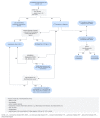Role of Fibrinolysis in the Management of Patients with COVID-19 and Thromboembolic Complications: A Review
- PMID: 36286308
- PMCID: PMC9604283
- DOI: 10.3390/jcdd9100356
Role of Fibrinolysis in the Management of Patients with COVID-19 and Thromboembolic Complications: A Review
Abstract
An impaired fibrinolytic process has been demonstrated in patients infected with SARS-CoV-2, including those in severe or critical condition. Disruption of fibrinolysis leads to fibrin deposition, which exacerbates inflammation and fibrosis and damages the pulmonary surfactant. Numerous authors point out the different course of coagulopathy in patients with COVID-19. It is reported that they may have a state of secondary hyperfibrinolysis, which may explain, at least in part, the increased incidence of venous thromboembolism, even among those patients already receiving appropriate anticoagulant treatment. This raises the question of whether current guidelines for the prevention and treatment of embolic-thrombotic complications, among patients with severe COVID-19, are sufficient. Some studies show evidence of clinical improvement in patients who have received fibrinolytic therapy, beyond the current indications for its implementation. However, when considering the inclusion of systemic fibrinolytic therapy, the benefits of such treatment should always be weighed over the risk of adverse effects. Thromboelastography and rotational thromboelastometry can be helpful in making such decisions. The purpose of this study was to review the current knowledge regarding fibrinolysis and its role in the treatment of patients with severe COVID-19, including those with thromboembolic complications.
Keywords: COVID-19; fibrinolysis; pulmonary embolism; venosus thromboembolism.
Conflict of interest statement
The authors declare no conflict of interest.
Figures
Similar articles
-
The role of rotational thromboelastometry during the COVID-19 pandemic: a narrative review.Korean J Anesthesiol. 2021 Apr;74(2):91-102. doi: 10.4097/kja.21006. Epub 2021 Jan 13. Korean J Anesthesiol. 2021. PMID: 33440114 Free PMC article. Review.
-
Fibrinolysis Shutdown Correlation with Thromboembolic Events in Severe COVID-19 Infection.J Am Coll Surg. 2020 Aug;231(2):193-203.e1. doi: 10.1016/j.jamcollsurg.2020.05.007. Epub 2020 May 15. J Am Coll Surg. 2020. PMID: 32422349 Free PMC article.
-
High D dimers and low global fibrinolysis coexist in COVID19 patients: what is going on in there?J Thromb Thrombolysis. 2021 Feb;51(2):308-312. doi: 10.1007/s11239-020-02226-0. Epub 2020 Jul 15. J Thromb Thrombolysis. 2021. PMID: 32671609 Free PMC article. Clinical Trial.
-
Fibrinolytic shutdown diagnosed with rotational thromboelastometry represents a moderate form of coagulopathy associated with transfusion requirement and mortality: A retrospective analysis.Eur J Anaesthesiol. 2020 Mar;37(3):170-179. doi: 10.1097/EJA.0000000000001096. Eur J Anaesthesiol. 2020. PMID: 31567468
-
Fibrinolysis in COVID-19: Impact on Clot Lysis and Modulation of Inflammation.Curr Drug Targets. 2022;23(17):1578-1592. doi: 10.2174/1389450123666221011102250. Curr Drug Targets. 2022. PMID: 36221881 Review.
Cited by
-
Rethinking the Role of the Renin-Angiotensin System in the Pandemic Era of SARS-CoV-2.J Cardiovasc Dev Dis. 2023 Jan 1;10(1):14. doi: 10.3390/jcdd10010014. J Cardiovasc Dev Dis. 2023. PMID: 36661909 Free PMC article.
References
Publication types
LinkOut - more resources
Full Text Sources
Miscellaneous


